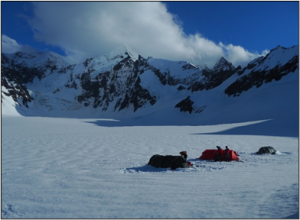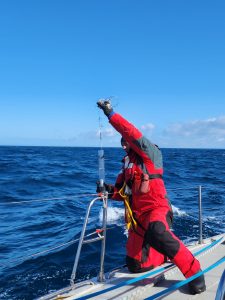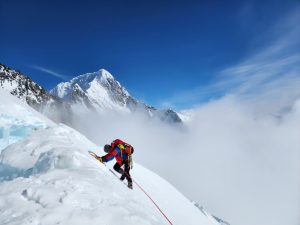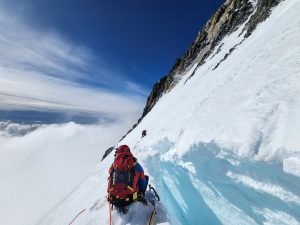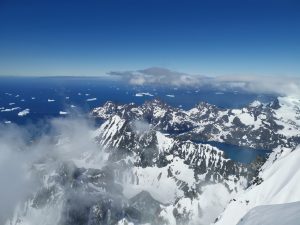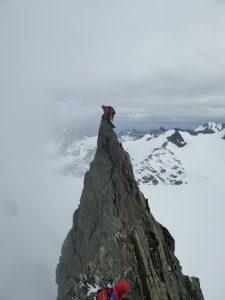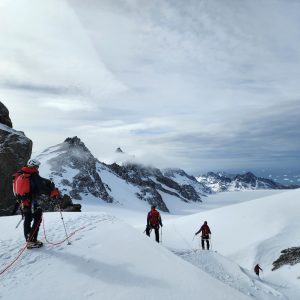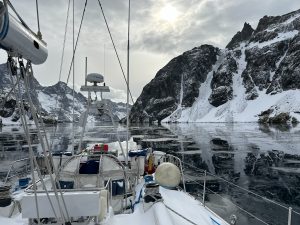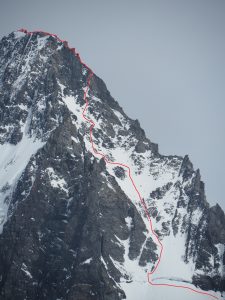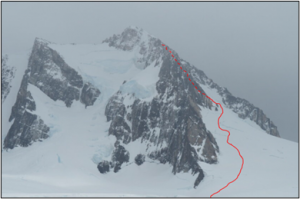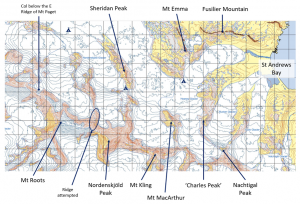SUMMARY
Over 25th Sep – 2nd Nov 2023, the Corps of Royal Engineers (British Army) embarked on a sailing and mountaineering expedition to South Georgia. The expedition had already sailed (using different crews) from the UK to the Falkland Islands in three legs and after South Georgia sailed up to the Caribbean in a further two legs. This report concerns Ex ATLANTIC QUEST’s Leg 4, which was the leg between the Falklands and South Georgia.
Our main objective was to conduct exploratory mountaineering, although we also had some scientific objectives and the sailing was not without challenge. At times we were pinned down by the famously wild weather as we expected, but not to the extent of previous expeditions. We did a lot of venturing around on foot and had some modest climbing successes, including the first ascent of Douglas Crag.
CONTEXT
This was a British military Adventurous Training (AT) expedition. As such, we were on-duty and had to work within the constraints of military AT policy and its qualifications framework. Of the 10 mountaineers:
- 2 had a depth of experience over decades of mountaineering and expeditions and held the highest military qualification in alpine mountaineering (Joint Service Alpine Mountaineering Instructor).
- 3 had a very good level of relevant experience and held the qualification of JS Alpine Mountain Leader.
- 5 were relative novices (for an expedition as remote as this), a couple of whom had only started climbing in the build-up to this expedition over the preceding two years. They held JS Alpine Mountaineering Foundation.
DIARY
25th – 30th Sep
Having left the Falkland Islands on 25th Sep, our yacht, Adventure of Hornet, arrived at Grytviken at dawn on 30th Sep. The remainder of the day was customs checks, yacht maintenance and getting our land legs back.
1st Oct
Dawned sunny and still. A glorious first day! Lots of recent fresh snow down to sea level. Different teams went for shake-out walks to the small peaks local to Grytviken, including Mt Hodges and Orca Peak.
2nd Oct
Poor weather. Made plans for coming days and prepped kit.
3rd – 6th Oct
We planned to get dropped off in Mercer Bay, to see if we might be able to climb Marikoppa or Quad Five (or Mt Fagerli or Paulsen Peak, which make up a small cirque of peaks) from the north side, coming up from the Geike Glacier. On the morning of 3rd Oct, we disembarked the dinghy mid-way down the western bank of Mercer Bay. We then dragged pulks southwards until the forward team reported that the way ahead was blocked (by a rib of rock and steep scree slopes). It would have been possible to scramble round the toe of the buttress at sea level but the weather was forecast to deteriorate over the next few days and such a sea level approach would be cut off if the sea picked up. There was a small beach just beyond which we could be ferried round to by dinghy but we opted to relocate instead, with a view to taking a look up the Lyell Glacier. So we moved by dinghy to the other side of the bay, from where we walked to Teie Point peninsula and set up camp for the night.
On 4th Oct, three rope teams walked in and set up camp on a plateau of the Lyell Glacier (at 360m). A fourth team walked up in light order and continued up to a prominent bump on the western ridge of the Lyell Glacier which they nick-named Pebble Peak1, before looping back to base camp on Teie Point. That night at the Lyell Glacier camp was very gusty and caused tents to invert despite being double-poled and behind snow walls.
On 5th Oct, the team at Teie Point [Ade, Dan, Jodi] decided to embark on a snowshoe walk back to Grytviken through Echo Pass. The other teams had an alpine start from the glacier camp and headed up to the col at c 750m that divides the Lyell and Geike Glaciers. They descended the far side (about 70m down a west-facing gully, Scot I-II) but were paused by a steep rock step 5m above the snow of the Geike Glacier. This step could have been abseiled and reclimbed on the way back but the snow conditions and risk of rockfall in this gully would only be getting worse through the day – so after some deliberation we decided as a team to err on the side of caution and turn around and remain on the Lyell side of the col.
In a bid to salvage something from the day, two teams [Joe, Kev; Si, Guy] headed a short distance east and climbed most of the way up snow gullies (Scot I/II) up the west face of ‘Point 780’ before deciding to climb back down due to the warming conditions.
Meanwhile, one team [Mike, Matt, Jack] did a repeat ascent of Waller Peak2 in the middle of the Lyell Glacier. From the saddle to the SW of the peak (and to NE of Pt 780), they did a couple of pitches along the SE ridge, traversed round on good snow to the SW face and then climbed a couple of mixed pitches (up to Scot II) to the exposed rock summit. Descent directly down the snow slopes of the W/SW face.
The three teams then overnighted again at the glacier camp. 6th Oct brought heavy rain and they walked out to Teie Point for pickup by the yacht.
7th – 8th Oct
Drying kit / reorganisation. Made plans to head south. On 7th Oct, two teams [Joe, Matt; Si, Dan, Jodi] climbed Mt Duse overlooking KEP.
9th Oct
Sailed down to Larsen Harbour where we anchored for the night.
10th – 13th Oct
On 10th, went ashore in Hamilton Bay and walked up the Salomon Glacier to establish a base camp, which we dug into a wind scoop below a rock outcrop at 600m asl.
On 11th, we broke into three teams for different objectives:
One team [Joe & Si] climbed Douglas Crag3 in a 15-hour roundtrip. They climbed up the snowfields of the NE face (mostly Scottish I-II but with a couple sections of II-III which were pitched), and onto the N ridge which led towards the summit. They followed this in five pitches (including the crux, a rock slab of around UIAA IV) until the ground eased and they then weaved their way up (and down and round) past two false summits to a third summit which they could be sure was the highest point around. They descended straight down a continuous snow gully / slope down the NW face, which led all the way to the bottom (Scottish I) and would be the easiest way up the mountain.
A second team [Ade, Kev, Matt, Jack, Guy] walked in towards a moderate-looking peak4 ENE of Pt 2229 but were thwarted by the state of the glacier immediately south of the objective and decided to turn back. They retraced their steps and – as a consolation prize – took in a rocky peaklet5 at the foot of the NE Face of Mt Macklin, which needed a little scrambling á cheval to reach the top.
A third team [Mike, Dan, Jodi] attempted Mount Macklin. They moved up the ever- steepening snow slopes of the NE face, weaving between crevasses, crossed the bergschrund and continued up (pitching now, alongside a rock rib) until, after eight pitches (up to Scottish III but mostly easier), they hit the summit ridge at 1,780m beside a large gendarme. They could see a highpoint a couple hundred metres distant6 and the way ahead along the ridge looked like interesting climbing, but the weather was deteriorating and they were out of time, so they descended the way they had come (with a mix of down- climbing and abseiling). On the crevassed steepish ground below the ‘schrund, the darkness and snowstorm made it tricky to relocate a safe way back down between some sizeable holes and – despite knowing it was a short distance until walking terrain – the decision was made to dig in until first light. At dawn on the 12th, they crawled out of their hasty snow hole and continued their descent, still in whiteout conditions due to thick cloud. Once on the glacier and walking back, they met a rope team of the others who had walked out to meet them, before returning to basecamp (arriving back 29 hours after leaving).
Later on the 12th, some objectives local to the campsite were attempted. One team [Kev, Guy] climbed a short, pleasant route up a bump which they nick-named Winged Peak7. Another team [Joe, Si, Matt, Jack] attempted a rocky peak8 on the N side of the Salomon Glacier – they encountered some of the best rock of the trip but were repulsed by the very final rock tower (which was too technical for the team in big boots).
On 13th, we awoke to a foot of fresh snow. We struck camp and returned down to Hamilton Bay for pickup before an inbound storm was forecast to arrive. We then sailed north and anchored in Ocean Harbour overnight in strong winds (at one point, the anchor dragged and had to be reset in the middle of the night).
14th – 15th Oct
On 14th we sailed round to Grytviken in snowy and windy weather.
15th remained poor weather; we attempted to dry kit and made further plans.
16th – 17th Oct
On 16th, we attempted to drop off one team on west bank of Mercer Bay to reattempt reaching Marikoppa / Quad Five from the north via the Geike Glacier. But the sea state was too rough for the dinghy so aborted. As a consolation, one team climbed Spencer Peak9 in a 4 hour round-trip from the yacht (some scrambling and snow, approx. Facile).
On 17th, prepped and packed kit to go ashore again.
18th – 21st Oct
On 18th Oct, nine of the mountaineers were dropped off on the Greene Peninsula, with a view to undertaking some objectives from the Nordenskjöld Glacier. We broke into two groups and both camped on the glacier at around 500m asl.
The first group [Joe, Si, Dan, Matt] had intentions of continuing to a higher camp from which an attempt on the East Ridge of Mount Paget might be possible. But when they awoke early on 19th, it was clear that daytime temperatures would be too hot to allow fast (or safe) movement up the glacier towards the col below the E Ridge of Mt Paget. So they quickly abandoned that plan and instead pulled pulks to the col immediately south of Sheridan Peak, where they set up camp and went on an afternoon walk up to 1,300m to take a look at potential objectives and “do some science”.
Meanwhile on the 19th, the second team [Mike, Guy, Jack, Kev, Jodi] also headed for the Sheridan col. Walking through the Nordenskjöld Glacier was tortuous and time-consuming. On snowshoes and dragging pulks, several people stepped through into crevasses and there was one fall which required a 3:1 extraction. No-one was injured thankfully and it was a relief to progress onto more mundane glacial terrain as we approached Sheridan Peak.
Midway between Mount Roots and Nordenskjöld Peak is a subsidiary peak10 with a fine- looking north ridge. On 20th Oct, one team [Joe, Si, Dan, Matt] climbed up and joined this ridge at around 1,000m, via a gully (Scottish II/III). But the wind was ferocious and the attempt was abandoned.
Meanwhile on 20th, the other group had an easy day and bumped their camp a few km east to the top of the Heaney Glacier. From there, they then had a very early start on 21st to try to beat the daytime heat. One rope team [Kev, Jodi] climbed Mount MacArthur to within 10m of the summit, before being repelled by the looseness of the rock at the very top (possibly exacerbated by the high temperatures). Meanwhile, another rope team [Mike, Guy, Jack] navigated through thick fog for a couple of hours to the base of a minor peak due east of Mt MacArthur, for which they offer the name Charles Peak11. This gave two enjoyable pitches of steep snow to the top.
All teams then walked out down the Heaney Glacier to St Andrews Bay for pickup by the yacht on afternoon 21st. The night of 21st was anchored in Ocean Harbour.
22nd – 27th Oct
On 22nd, we sailed round to Grytviken, then conducted kit maintenance and rested.
There looked to be one final weather window possible, but we awoke at 4am on 23rd to 35 kt gusts at the Grytviken jetty and it was decided against dropping anyone ashore further afield. That afternoon, we had a football match against a combined BAS-GSGSSI team on a hilariously cold and water-logged pitch.
The 24th Oct was poor weather and we remained alongside in Grytviken for people to do touristy things.
As a team, we had agreed from the outset that we would start to look for a weather window for the return sail from 25th Oct and it was therefore obvious that by now the mountaineering phase was all but over. Our departure was looking like 27th Oct (with a day of yacht prep on 26th) so we had one final day of opportunity on 25th.
Various teams went out on 25th and enjoyed summitting peaks local to Grytviken in fantastically sunny weather. Conditions had changed a lot over the preceding month and the low hills were far more Spring-like than when we arrived, although there was still a lot of snow around, especially on southern aspects. Of interest, one team [Si, Mike, Dan] climbed a line direct up the east face of Narwhal Peak to its summit, which was mostly steep snow but included one pitch over a rock band.
We sailed on 27th Oct, arriving back in the Falklands seven days later.


